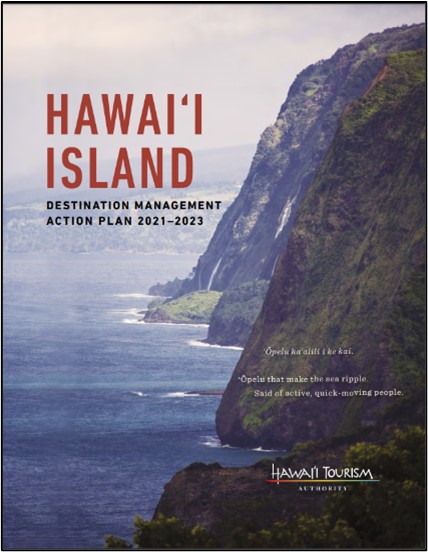HTA Publishes Community-Based Tourism Management Plan for Hawai‘i Island

The Hawai‘i Tourism Authority (HTA) has published the 2021-2023 Hawai‘i Island Destination Management Action Plan (DMAP). It is part of HTA’s strategic vision and continuing efforts to manage tourism in a responsible and regenerative manner. It was developed by the residents of Hawai‘i Island, and in partnership with the County of Hawai‘i and the Island of Hawai‘i Visitors Bureau (IHVB). The DMAP serves as a guide to rebuild, redefine and reset the direction of tourism on Hawai‘i Island. It identifies areas of need as well as solutions for enhancing the residents’ quality of life and improving the visitor experience.
“Our heartfelt gratitude goes to the resident participants of Hawai‘i Island who committed themselves to the DMAP process and were willing to face tough issues, embrace diverse viewpoints, explore a range of possibilities, and identify actionable priorities. Enhancing the quality of life within our local communities by protecting and caring for the things we cherish most, will subsequently provide a unique array of experiences for travelers who are mindful of and respectful to the places they will visit on the island,” said John De Fries, HTA’s president and CEO.
The community-based plan focuses on key actions that the community, visitor industry and other sectors deem necessary over a three-year period. The foundation of the Hawai‘i Island DMAP is based on HTA’s 2020-2025 Strategic Plan and the 2020-2025 Hawai‘i Island Tourism Strategic Plan (TSP).
“The vision for tourism on Hawai‘i Island is ‘Ola ka ‘Āina, Ola ke Kānaka’ – ‘Healthy Land, Healthy People.’ What this means is destination resilience: protecting our natural and cultural resources, and helping our community thrive not just survive. The County of Hawai‘i is working on strategies that lift up tourism as a catalyst for economic diversification. The Destination Management Action Plan identifies actions that help the county partner with the visitor industry to get people back to work in a diversified way, while protecting our land and our people,” said Hawai‘i County Mayor Mitch Roth.
The actions of the Hawai‘i Island DMAP are based on the four interacting pillars of HTA’s Strategic Plan – Natural Resources, Hawaiian Culture, Community and Brand Marketing:
Natural Resources
- Protect and preserve culturally significant places and hotspots.
- Support and promote ‘āina-based education and practices to protect and preserve our natural resources so that residents and visitors will aloha ‘āina.
- Connect with community networks and partner with community-based organizations to collaboratively identify sites, set carrying capacities, and implement stewardship plans to protect and preserve our natural resources.
Hawaiian Culture
- Develop resources and educational programs to perpetuate authentic Hawaiian culture and ‘Ōlelo Hawai‘i. April 1, 2021 (21-09)
Community
- Create opportunities for ongoing dialogue, communications, and engagement between the visitor industry, government and communities to improve community-industry relations and better serve the community.
- Promote agritourism, and partner with Hawai‘i Island’s agriculture industry to support local food security.
- Invest in community-based programs that enhance quality of life for communities.
- Advocate/create more funding sources to improve infrastructure.
Brand Marketing
- Implement a comprehensive communications and education plan that facilitates positive community-visitor relations and pono practices, including the Pono Pledge.
- Improve enforcement of vacation rental regulations.
These actions were developed by the Hawai‘i Island steering committee, comprised of residents representing the communities they live in, as well as the visitor industry, different business sectors, and nonprofit organizations, with community input. Representatives from the County of Hawai‘i, the Hawai‘i Island TSP Action Cohorts, HTA and IHVB also provided input throughout the process.
“It is truly my desire that these recommendations manifest into positively changing the level of consciousness of both residents and visitors. As residents, we greatly value and care for our island home and lifestyle and need our visitors to respect and value it as well. Travelers that walk and explore with a heightened level of purpose and intention can be a part of improving and preserving our beautiful home,” said Ka‘iulani Blankenfeld, director of Hawaiian culture at Fairmont Orchid and steering committee member.
The Hawai‘i Island DMAP process started in July 2020 and continued with a series of virtual steering committee meetings, as well as two virtual community meetings in November.
“It was very rewarding for me personally to have been invited to participate in helping to shape a new path and strategy for rebuilding our tourism industry. I learned a lot from my colleagues and am particularly enthusiastic that addressing the resident and community concerns around the social, cultural and environmental impacts are treated as actionable issues,” said Charles Young, Ho‘okena representative for the ‘Aha Moku Advisory Committee and steering committee member.
Click here for the Hawai‘i Island Destination Management Action Plan.

